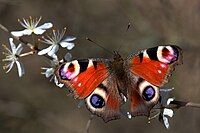
Photo from wikipedia
BACKGROUND Diapause allows insects to survive harsh environments, and its termination is crucial for their normal development after diapause. However, little is known about the regulatory pathways and signals involved… Click to show full abstract
BACKGROUND Diapause allows insects to survive harsh environments, and its termination is crucial for their normal development after diapause. However, little is known about the regulatory pathways and signals involved in insect diapause termination. RESULTS We discovered that high temperature (25 °C) influenced larval diapause termination in Monochamus alternatus. Likewise, metal ions (Ca2+ ) promoted diapause termination by reducing diapause duration. We combined transcriptomic and metabolomic analyses to investigate changes in gene expression and metabolism in diapause-terminated larvae treated with high temperature (MaHt) and metal ions (MaCa). Hormone biosynthesis and metabolism contained the highest proportion of significant differentially expressed genes (DEGs) in the two groups. 20-hydroxyecdysone (20E) and juvenile hormone (JH) were closely related to diapause termination in M. alternatus. RNAi experiments verified that 20E biosynthesis (CYP314a1) and degradation (CYP18a1), JH biosynthesis (FOHSDR-1) and degradation (JHEH) genes affected the larval diapause duration significantly. In addition, dysfunction of CYP314a1 resulted in increased larval mortality (p<0.01), reduced pupation rate and emergence rate (p<0.05). ELISA analysis showed that the ecdysone content decreased after dsCYP314a1 injection and JH content increased after dsJHEH injection. CONCLUSION The results indicate that genes CYP314a1, CYP18a1, FOHSDR-1 and JHEH mediated 20E and JH biosynthesis and degradation to regulate diapause termination in M. alternatus. We elucidated the molecular mechanism underlying the regulation of diapause termination and provided a basis for the prevention and control of M. alternatus infestation. This article is protected by copyright. All rights reserved.
Journal Title: Pest management science
Year Published: 2022
Link to full text (if available)
Share on Social Media: Sign Up to like & get
recommendations!